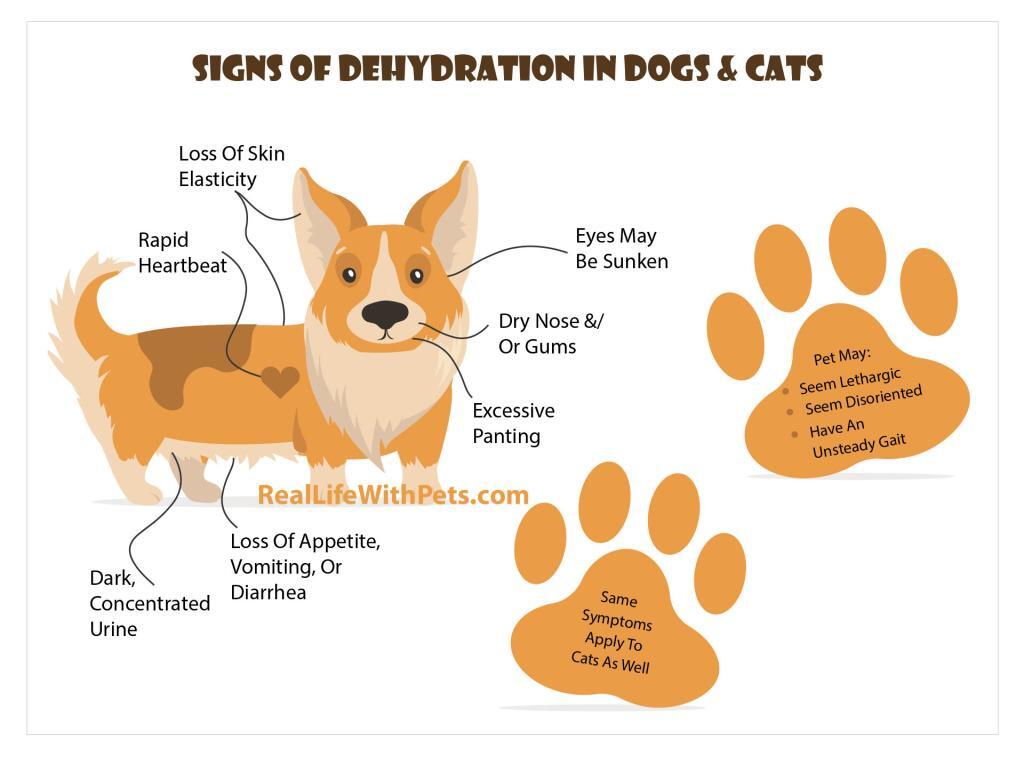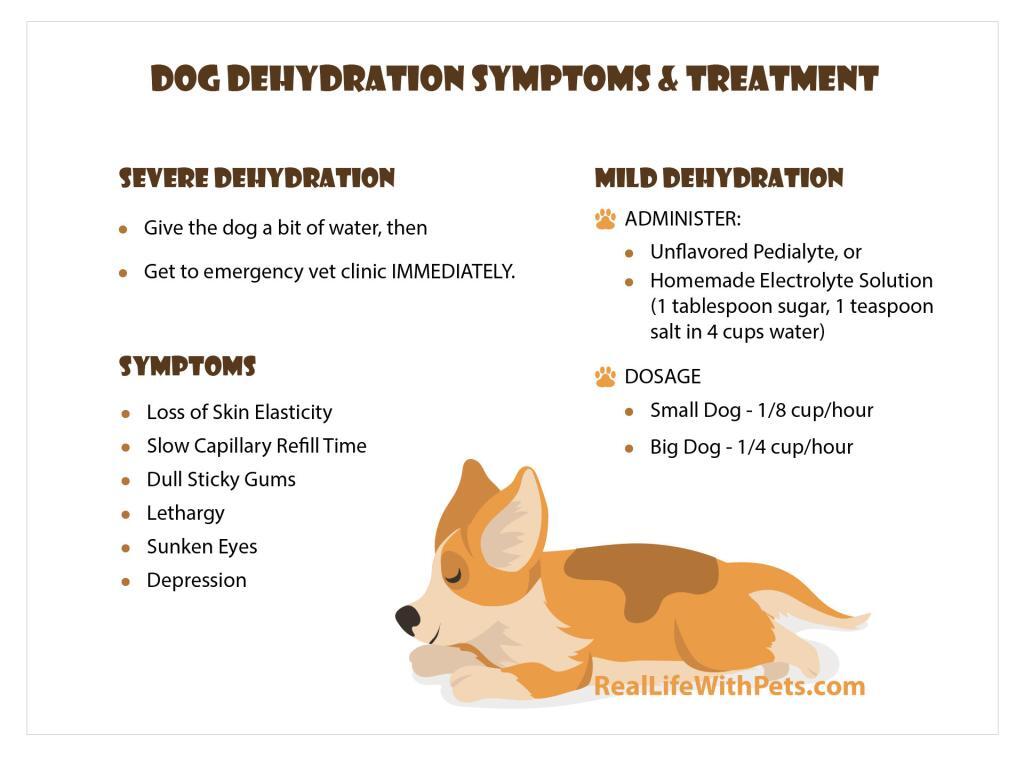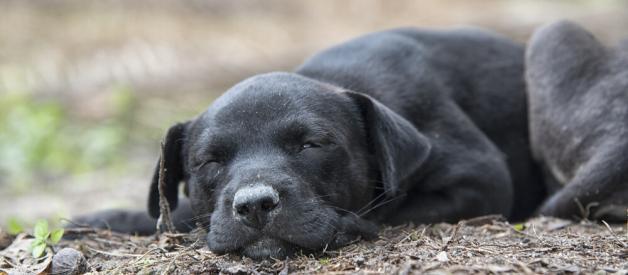Table of Contents
Dehydration in animals is a potentially life-threatening condition. This is because a pet has lost too much liquid due to hot or dry weather or excessive activity or due to insufficient electrolyte and water intake. A veterinarian’s involvement is not always necessary, but it is important to identify dehydration in time to prescribe medication. If dehydration is neglected or ignored, it may cause serious illness, psychological problems in pets, and, in a severe and advanced form of the disease, even death.
What is Dehydration?
Dehydration is a decrease in total body water. Dehydration can be caused either by a decrease in water intake by the pet or due to some diseases.
Animals often live in conditions where they cannot find water. Therefore, dehydration occurs due to the irresponsibility of a human being. For example, dehydration in dogs often occurs after an active walk with the owner.
Let’s discuss the causes and symptoms of dehydration as well as its treatment.
Causes of Dehydration
The risk of losing body water increases in hot or dry weather. Pay attention, that dry weather can happen not only in summer but in winter as well! House heating makes the air dry, that’s why an animal should drink a lot of water. The main effect of dehydration in animals is:
Due to diseases or other causes:
- nausea (much water comes out with vomiting);
- depression;
- pain in the abdomen or while urinating (the animal stops drinking);
- diarrhea;
- shortness of breath;
- heatstroke;
- sunstroke;
- loss of liquid through panting;
- frequent urination that usually is caused by diabetes, kidney failure, or other health problems.
Due to the human factor:
- inadequate daily fluid intake;
- dirty dishes from which the pet drinks;
- not replacing fluid after activity;
- being away for a quite long time while the animal has drunk all the water from its bowl.
Symptoms of Dehydration in Pet
It is vital to recognize the signs of dehydration in time so you can take action. You don’t have to panic and immediately drive to the doctor. You can cope with low-grade dehydration at home. Pet’s signs of losing water are very important to notice at the initial stage. In this case, they are easier to minimize. How to understand that an animal needs more liquid?

Signs of dehydration may be:
- dry nose or/and eyes;
- sunken eyes;
- loss of appetite;
- dark urine;
- loss of fur shine;
- dry gums;
- excessive drooling;
- thick saliva;
- lethargy;
- difficulty breathing;
- disorientation;
- skin irritation;
- weakness;
- loss of skin elasticity;
- annoyed behavior, aggression;
- tacky mucous membranes;
- slowed mental activity;
- cloudy cornea;
- wobbly walk;
- white gums that linger when pressed;
- heart rate above 140;
- weak pulse;
- hypovolemic shock, or shock occurring from fluid loss;
- increase in urine odor.
Signs of dehydration in cats and dogs are usually very similar.
Is There a Home Test for Dehydration in Animals?
Do you want to check if your animal has lost body liquid? Pinch a skin on the top of the cat’s or dog’s head with the forefinger and thumb. If the water level is enough, the skin will spring back. Otherwise, it should move back more slowly or will not spring back in case of severe dehydration.
There is another home test. Use your finger and press on the gums of the pet. Be gentle but press with enough force. When you stop pressing the area should become white because the blood has been forced out. After that measure how much time it takes for the blood to come back. Your pet may be dehydrated if it takes 1,5 seconds for the blood to come back.
How Does Vet Test My Pet for Losing Body Water?
If the veterinarian suspects losing body liquids in your pet, a blood sample can help. It is one of the quickest ways to identify the degree of dehydration. The blood test can also help clarify a cause and the doctor make take quick decision on how to treat it. The blood will be taken from a vein in the neck or a vein in the front leg.
Clipping a small patch of fur will help the vet easily find the vein. In case the blood is taken from a leg, the vet will apply a small bandage to prevent any further bleeding. Within several hours the bandage can be removed.
Dehydration Treatment
Loss of body water in cats and dogs is treated with fluid replacement. Offer them a small amount of liquid – water, broth, or cool water in hot weather (but not ice cold!). However, some dehydrated patients will require intravenous rehydration injection. This can only be done by a veterinarian! Do not give the animals juices, soda, sports drinks, or water with flavors and additives. Avoid giving plenty of water because it may lead to vomiting.

The underlying conditions that cause body water loss should also be treated with medications. It can be medicines that you can buy without a prescription or online – diarrhea medicines, anti-vomiting medicines, and antipyretic medicines.
Home Remedies for Dehydration in Pets
Treating dehydration in cats is the same as in dogs. Before contacting the veterinarian, it is worth doing home treatment. What you may do at home for dehydration:
- Wash the water bowl for the pet so that there are no bacteria in it that make the pet reluctant to drink.
- Add some chicken broth or fish/meat broth to the water.
- Instead of dry food, try giving them wet food.
- Encourage your pet when he drinks.
- Try giving the animal a small amount of water.
- Place ice cubes in a water bowl.
Preventing Dehydration
To prevent dehydration in pets, you should be very careful. Prevention is indeed the most important treatment for dehydration. People should not walk their pets during extreme heat, dry weather, or the hottest time of the day. Owners of particularly active animals, especially dogs, should pay much attention to replacing water in their animals.
- Take a bottle of water with you when you go for a walk with your pet;
- Wash the bowl with the pet’s water regularly;
- Remember to refill your bowl of water when you leave;
- Remember to refill your bowl of water when you go to bed;
- If the animal does not feel well and refuses to drink, contact your veterinarian.
Preventing dehydration is easier and safer than dealing with the consequences later.
FAQ
How Long Can an Animal Go Without Water?
In normal weather, the animal can safely go without liquid for about 72 hours, but after 24 hours the first symptoms and deterioration occur.
What if the Dog Refuses to Drink?
This most likely means that the animal is experiencing discomfort due to the drinking process or pain. Better take your pet to the veterinary. But to stimulate the dog to drink, you can offer something tastier than water, for example, fish or meat broth.
Can a Cat Recover from Dehydration?
Yes, cats and dogs as well have every chance to recover from dehydration. Mild and even severe dehydration is treated. You only have to be aware of what to do if you think your animal is dehydrated.
How Can I Rehydrate My Pet?
Wash a bowl of water, add something tasty and smelly to the water, praise the animal after drinking, and monitor the health situation. In an emergency, inject liquid into the pet’s mouth with the help of a syringe without a needle.
How Do I Know if an Animal Is Dehydrated?
To understand that the animal is dehydrated, you need to notice the first signs of dehydration in dogs and cats – dryness in the mouth, dry eyes, changes in behavior, aggression, weakness, lethargy, vomiting, diarrhea, changes in the sound and smell of urine. You may also test the pet’s skin as was written in this article.
How Long Does It Take to Rehydrate a Dog?
Doctors advise following the rule: if your dog is small, he should drink 1/8 cup per hour and 1⁄4 cup for large dogs. It may take several hours for your dog to recover. Monitor your animal for the next several hours. Stay indoors for the rest of the day. If you think that the pet doesn’t recover, contact the vet.
How Do You Make Electrolytes for Dogs?
There is an easy recipe. You need to take 4 pints of water. Water should be boiled and cooled. Add one teaspoon of salt, and four teaspoons of sugar, stir well and serve at room temperature.
Will a Dog Pee if It’s Dehydrated?
If the pet doesn’t take in enough liquid, his urine will be a very dark yellow color. But if the bladder is completely empty, the animal won’t urinate at all.























